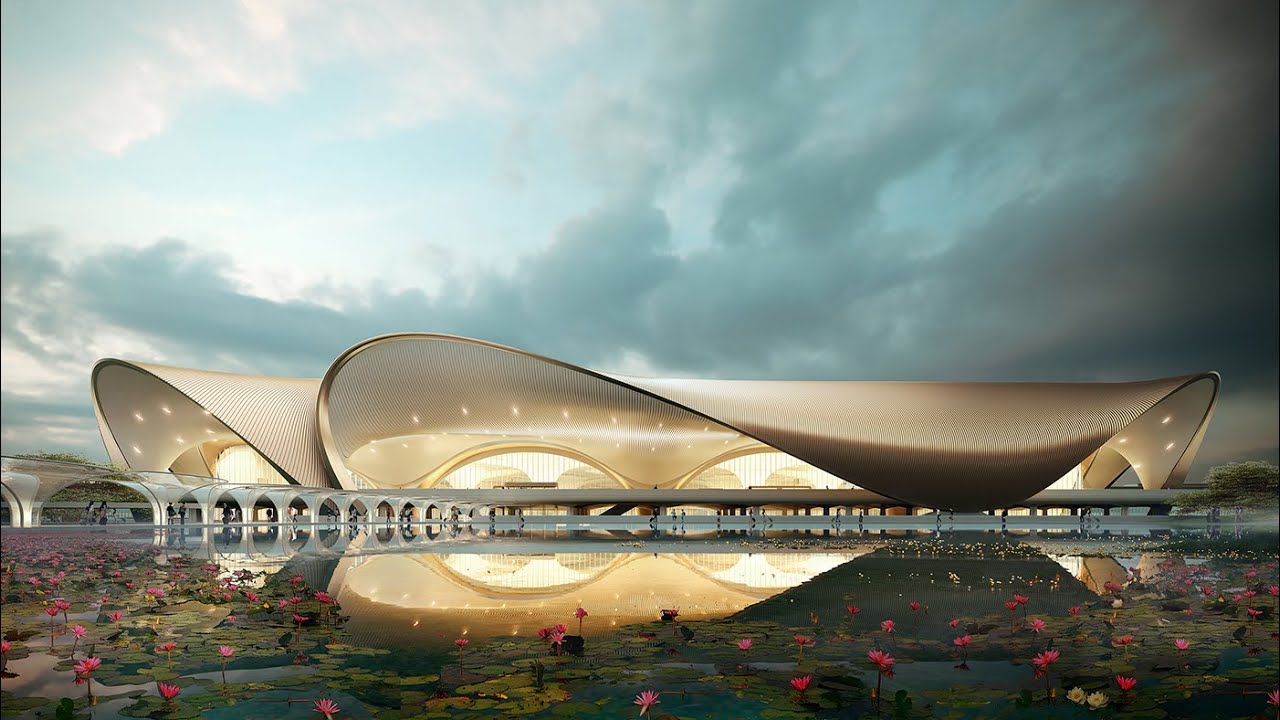The ideation and planning of Navi Mumbai International Airport is a radical yet unique greenfield project. The increase in Mumbai’s population density, traffic, pollution, and demand for resources planted seeds for the creation of a satellite city in the early 1960s. “Navi Mumbai” was planned to cater to the overwhelming needs of the metro city. Situated beyond the suburbs of Mumbai, the planners envisioned an efficiently planned city with world-class infrastructure and amenities.

Master architect Charles Correa in collaboration with the City and Industrial Development Corporation (CIDCO) did the urban design of Navi Mumbai. Navi Mumbai has a well-planned Mass Rapid Transport System (MRTS) that seamlessly connects all nodes of the city and sets an excellent example of public transport planning. In order to complement such efficient transportation connectivity of the city and to shed the load off Mumbai’s international airport (CSMIA), the government floated plans for Navi Mumbai International Airport.
Timeline of the Airport Development
We can trace the inception of Navi Mumbai International Airport (NMIA) to as early as 1997 when the Central Aviation Ministry set up a panel to discuss the development of a second airport in Mumbai. However, the government shelved the project for a decade and progressed towards development only after the Union Cabinet’s principle approval in 2007.

The government plans on executing the project in 4 phases, with CIDCO as the nodal agency for the project. Accordingly, they invited requests for qualification tenders in 2014. The project received environmental clearance for stage 2 in 2016 which led to the beginning of redevelopment works in 2017. With all permissions and clearances received, they held the ground-breaking ceremony of the airport site in 2018 in the presence of the Prime Minister of India, Shri Narendra Modi.
Conceptualisation of Navi Mumbai International Airport
The Site and Design
The site for Navi Mumbai airport is located in the Kopar-Panvel area. They designated it as one of the world’s largest greenfield airports. The GVK Group led by Mumbai International Airport Limited (MIAL) and CIDCO has been pivotal in realising this visionary project. Zaha Hadid Architects did the architectural design of Navi Mumbai airport. This globally acclaimed firm is famous for their breakthrough design forms. The airport’s fluidity of form proposed by the firm resembles principles of deconstructivism and parametricism. These are native to Hadid’s design style.

The Master Plan, Design and Planning
The master plan of the airport received CIDCO’s approval in 2019. The airport design takes its inspiration from the flower lotus, which is of significant value in Indian culture. It symbolises elegance and purity. The design of NMIA is a blend of India’s culture and essence with modernity, which provides the airport its uniqueness. The airport will accommodate 3 interconnected multi-level terminals spread over an area of 11.6 sq. km. Planned with two parallel runways, the Navi Mumbai International Airport at its fully functional capacity expects to serve 90 million passengers every year. The first phase of the Navi Mumbai International Airport is expected to be completed and functional by 2023. The design of the airport plans to equip it with cargo terminal buildings, taxiways, apron area, cargo complex, aircraft maintenance site, and parking along with other infrastructural facilities
This design incorporates dual entrances from the West and the East of the airport building of the Navi Mumbai International Airport. The design of the airport equips it with state-of-the-art technology capable of managing simultaneous operations with water transport, suburban rail metro, and expressway connectivity. The central terminal complex is planned along a landscaped road connected by 9+9 lanes. On a zoning level, the eastern part of NMIA will be used for general aviation and cargo. Similarly the western and northern parts are planned for passenger-driven amenities. This has helped in clearly segregating vehicular traffic between the entrances.

The Prevailing State
Projects of gigantic scale such as the NMIA face frequent roadblocks. This is because of the impact they have on the place and people. These pressing issues are of urban significance and need empathetic consideration to achieve holistic project development. One such challenge that the NMIA is facing is that of the Project Affected People. The land acquired for constructing the Navi Mumbai International Airport was previously home to 3500 families across 10 villages. The government proposed the rehabilitation of these families. Although they executed the rehabilitation seamlessly, many tenants are unhappy with their living conditions or the compensation received to vacate the space.
Environmental Impact

The environmental impact of the project has been a lingering matter of concern. Environmentalists suggest that the existing site of NMIA is rich in mangroves. This is the habitat of several species of animals and birds. Experts recommended that an alternate site would have helped save the unique biodiversity of this site. This would thus lower the environmental impact of the project. A majority of the site area had water bodies. The design proposed to fill them and raise them by 2-5 m easing the airport construction. Experts consider such invasive ideas to be posing as major construction challenges on the airport site.
The Way Forward
With the construction works of other phases of NMIA approaching commencement, the real estate sector in Navi Mumbai is leveraging it. The new airport would benefit the housing market by improving the saleable value of built-up areas. This will help in generating employment opportunities in the real estate industry. The proximity to the airport will further increase the commercial value of the plots in Navi Mumbai. Such developments will improve the city’s liveability index by contributing to the quality of life of its people.
Sources:
- Impact of Navi Mumbai airport on property market
- Navi Mumbai airport: ‘How can development risk such damage to people, economy and ecology?
- Navi Mumbai International Airport- Boon or bane?
- A lotus-shaped landing field: GVK group reveals Navi Mumbai airport design
Disclaimer: The information contained herein have been compiled or arrived at, based upon information obtained in good faith from sources believed to be reliable. The opinions expressed within the content are solely the author’s and can be subject to change. The image featured in this article is only for illustration purposes. If you wish the article to be removed or edited, please send an email to editor@biltrax.com
Discover more from Biltrax Media, A Biltrax Group venture
Subscribe to get the latest posts sent to your email.






















